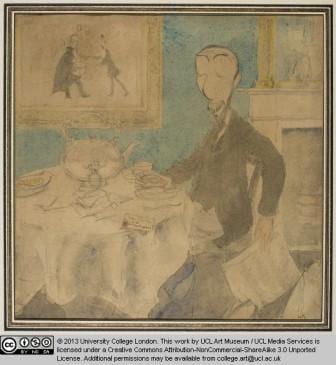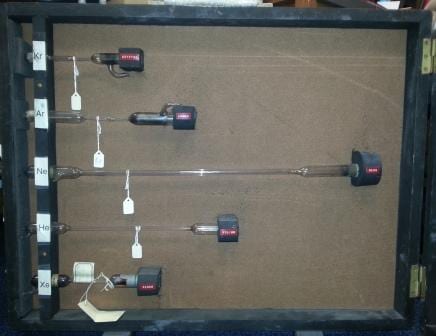An un-noble argument over a Nobel subject
By Emma-Louise Nicholls, on 19 February 2014
 After a few drinks last weekend, my sister, who is doing a Ph.D at a ‘different’ university, and I got in to a friendly ‘my horse is bigger than your horse’. I gloated that UCL has tentacles that reach around the world, is ranked within the top four universities within the UK, and most importantly (because this is how I measure university performance) we have several Nobel Prizes. Well as it turns out, so does her university, but the important thing is that we have more.
After a few drinks last weekend, my sister, who is doing a Ph.D at a ‘different’ university, and I got in to a friendly ‘my horse is bigger than your horse’. I gloated that UCL has tentacles that reach around the world, is ranked within the top four universities within the UK, and most importantly (because this is how I measure university performance) we have several Nobel Prizes. Well as it turns out, so does her university, but the important thing is that we have more.
Although the conversation was entirely (ok, mostly) in jest, it made me curious as to how justified my claims of ‘having a bigger horse’ actually were and I set about some googling. As luck would have it, even after calibrating the data for variables such as my university is around 130 odd years older than hers, and also taking into consideration the fact that the Nobel Prize only began in 1901 whereas we were founded in 1827, UCL are still higher achievers. Mwah hah hah. According to the website www.nobelprize.org, there have been 487 Nobel Prizes given out worldwide since its inception. Well let me hear an ‘oooo’ for the fact that 21 of those belong to us. As in UCL, not my sister and myself.
Unfortunately, none of the Nobel Laureates are from the Grant Museum (yet), but that’s obviously due to the fact that there are only five types of Nobel Prize, none of which are for zoology. They are physics, chemistry, literature, medicine and of course, peace. This new information makes me think it’s going to be harder to get my Nobel Prize for fossil shark research than I first thought. There is also the Prize for Economic Sciences, which began in 1968 as a tribute to Alfred Nobel, who started the original five. So far, 74 of these have been awarded (none to UCL). Our prizes have been for the following:
• 1904 Chemistry: Sir William Ramsay
• 1913 Literature: Rabindranath Tagore
• 1915 Physics: Sir William Henry Bragg
• 1921 Chemistry: Frederick Soddy
• 1922 Physiology or Medicine: Archibald Vivian Hill
• 1928 Physics: Owen Willans Richardson
• 1929 Physiology or Medicine: Sir Frederick Gowland Hopkins
• 1936 Physiology or Medicine: Sir Henry Hallett Dale
• 1944 Chemistry: Otto Hahn
• 1947 Chemistry: Sir Robert Robinson
• 1955 Chemistry: Vincent du Vigneaud
• 1959 Chemistry: Jaroslav Heyrovsky
• 1960 Physiology or Medicine: Peter Brian Medawar
• 1962 Physiology or Medicine: Francis Harry Compton Crick
• 1963 Physiology or Medicine: Andrew Fielding Huxley
• 1970 Physiology or Medicine: Bernard Katz
• 1970 Physiology or Medicine: Ulf Svante von Euler
• 1988 Physiology or Medicine: Sir James Black
• 1991 Physiology or Medicine: Bert Sakmann
• 2007 Physiology or Medicine: Professor Sir Martin Evans
• 2009 Physics: Professor Charles Kao
So you can see not only are we a university of over achievers, we are also quite consistent about it. We are only missing peace, then we will have the full set of Nobels. Perhaps that’s the one I should apply for then?
 Now I wanted to know what a Nobel Prize looked like. I could wait until I receive my own, but ever the impatient child, instead I contacted Nick Booth, the curator of the Teaching and Research Collections (Science and Engineering) to look at the one in the collections he looks after. The first of UCLs Nobel Prizes was awarded for chemistry, and so naturally, is kept in the chemistry department. Nick took me to the office of Alwyn Davies, an emeritus professor in organic chemistry and former head of the department of chemistry. Alwyn doesn’t just have the medal and certificate, he also has the very experiments with which Sir William Ramsay discovered five brand new elements, for which he was awarded the Prize. Ramsay is pictured above ‘hearing the news of his award’ in the image kindly supplied by UCL Art Museum. Alwyn got out a tesla coil (a bit like a cattle prod), and sequentially zapped each of the geissler tubes pictured above with it, until they produced different colours as the gasses in the tubes reacted to the current being passed through them. Above and beyond how pretty it was, it felt absolutely incredible to see what William Ramsay himself had seen, using the very same set of samples and equipment, over a century later.
Now I wanted to know what a Nobel Prize looked like. I could wait until I receive my own, but ever the impatient child, instead I contacted Nick Booth, the curator of the Teaching and Research Collections (Science and Engineering) to look at the one in the collections he looks after. The first of UCLs Nobel Prizes was awarded for chemistry, and so naturally, is kept in the chemistry department. Nick took me to the office of Alwyn Davies, an emeritus professor in organic chemistry and former head of the department of chemistry. Alwyn doesn’t just have the medal and certificate, he also has the very experiments with which Sir William Ramsay discovered five brand new elements, for which he was awarded the Prize. Ramsay is pictured above ‘hearing the news of his award’ in the image kindly supplied by UCL Art Museum. Alwyn got out a tesla coil (a bit like a cattle prod), and sequentially zapped each of the geissler tubes pictured above with it, until they produced different colours as the gasses in the tubes reacted to the current being passed through them. Above and beyond how pretty it was, it felt absolutely incredible to see what William Ramsay himself had seen, using the very same set of samples and equipment, over a century later.
 The periodic table was originally created by Dmitri Mendeleev in 1869. The five new elements that Ramsay discovered required the addition of a whole new area. The delightful Alwyn told me that “Ramsay was friends with Mendeleev, even though he did muck up his table”. Knowing academics as I do, I’m surprised that they rose above such a thing. The Prize itself, pictured here, comprises a beautiful hand-painted and leather bound certificate, and a large solid gold medal. Ramsay won several other medals during his career, some of which are also in the display case that holds the Nobel medal. As I was oohing and aahing over the shiny objects, Alwyn told me a secret. Ramsay had been an especially patriotic fellow and it is rumoured that he had his precious medals melted down in order to aid the war effort of World War One. Wowsers, that is patriotic. It should be possible to tell the difference between a real gold medal and a gold plated reproduction using an electron microscope, but as there is no evidence to support the rumour, it doesn’t really seem necessary said Nick. Well either way I don’t care- they’re still shiny. And we still have more Nobel Prizes than my sister.
The periodic table was originally created by Dmitri Mendeleev in 1869. The five new elements that Ramsay discovered required the addition of a whole new area. The delightful Alwyn told me that “Ramsay was friends with Mendeleev, even though he did muck up his table”. Knowing academics as I do, I’m surprised that they rose above such a thing. The Prize itself, pictured here, comprises a beautiful hand-painted and leather bound certificate, and a large solid gold medal. Ramsay won several other medals during his career, some of which are also in the display case that holds the Nobel medal. As I was oohing and aahing over the shiny objects, Alwyn told me a secret. Ramsay had been an especially patriotic fellow and it is rumoured that he had his precious medals melted down in order to aid the war effort of World War One. Wowsers, that is patriotic. It should be possible to tell the difference between a real gold medal and a gold plated reproduction using an electron microscope, but as there is no evidence to support the rumour, it doesn’t really seem necessary said Nick. Well either way I don’t care- they’re still shiny. And we still have more Nobel Prizes than my sister.
Emma-Louise Nicholls is the Curatorial Assistant at the Grant Museum of Zoology
.
2 Responses to “An un-noble argument over a Nobel subject”
- 1
-
2
prof prem raj pushpakaran wrote on 2 December 2018:
prof prem raj pushpakaran writes — Ulf Svante von Euler, the great Swedish physiologist who discovered the neurotransmitter, norepinephrine, was born on February 7th 1905!!!
 Close
Close


[…] Art) and it was this, along with his discovery of argon, neon, krypton and xenon, that won him the Nobel Prize for Chemistry in 1904. There’s a couple of labs named after him, and arguably without him our neighbouring area […]